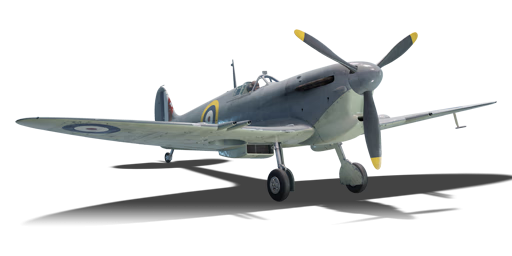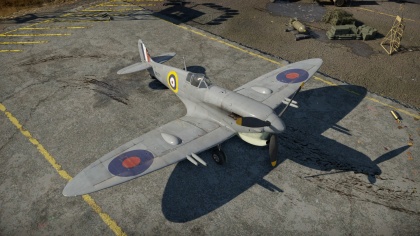Difference between revisions of "Spitfire Mk Vc/trop"
(→Usage in battles: Preliminary save so my edits don't get wiped. Don't approve it... yet.) (Tag: Visual edit) |
(Wiping this section in preparation for a **FULL** re-write. In my opinion, the Spitfire Vc/trop's current article gives it a bit of a bum rap.) (Tag: Visual edit) |
||
| Line 144: | Line 144: | ||
== Usage in battles == | == Usage in battles == | ||
| − | <!-- ''Describe the tactics of playing in an aircraft, the features of using vehicles in a team and advice on tactics. Refrain from creating a "guide" - do not impose a single point of view, but instead, give the reader food for thought. Examine the most dangerous enemies and give recommendations on fighting them. If necessary, note the specifics of the game in different modes (AB, RB, SB).'' --> | + | <!-- ''Describe the tactics of playing in an aircraft, the features of using vehicles in a team and advice on tactics. Refrain from creating a "guide" - do not impose a single point of view, but instead, give the reader food for thought. Examine the most dangerous enemies and give recommendations on fighting them. If necessary, note the specifics of the game in different modes (AB, RB, SB).'' --> |
| − | |||
| − | |||
| − | |||
| − | |||
| − | |||
| − | |||
===Manual Engine Control=== | ===Manual Engine Control=== | ||
Revision as of 11:59, 5 January 2020
Contents
| This page is about the British fighter Spitfire Mk Vc/trop. For the non-tropical version, see Spitfire Mk Vc. For other uses, see Spitfire (Family). |
Description
The Spitfire Mk Vc/trop is a rank III British fighter
with a battle rating of 5.3 (AB) and 4.7 (RB/SB). It has been in the game since the start of the Open Beta Test prior to Update 1.29, originally under the name Spitfire Mk Vc, however this was changed in Update 1.77 "Advancing Storm" to the current and accurate name.
The Spitfire Vc/trop is a plane with two major advantages over its opposition: turn performance, engine performance below 3000 metres, and armament. The plane is blessed with a Merlin 45M engine that grants it phenomenal acceleration below that altitude compared to german opposition, as well as a hard-hitting armament of four Hispano Mark II cannons.
Due to its 4.7 BR in realistic battles, the Vc/trop will be forced to fight against planes such as the Bf 109 G-2/trop, which performs better in the vertical (climbing/diving), or the A6M5, which performs better in the horizontal (turning). In an uptier into a 4.7/5.0 battle - which is an odd-to-regular occurrence depending on whether players are playing more of tier III aircraft or Tier IV aircraft - this aircraft faces opposition such as the Fw 190 A-8, the Fw 190 C, the Bf 109 G-6 and the A7M1 (NK9H).
In arcade battles, where it possesses a BR of5.3, it will be put with far superior planes such as the Fw 190 D-9 and Spitfire F Mk 22.
While this aircraft faces tricky opposition, it is far from helpless. If used correctly, this aircraft can easily ruin the day of any axis pilot.
General info
Flight Performance
Describe how the aircraft behaves in the air. Speed, manoeuvrability, acceleration and allowable loads - these are the most important characteristics of the vehicle.
| Characteristics | |||||||
|---|---|---|---|---|---|---|---|
| Stock | |||||||
| Max Speed (km/h at 3,963 m) |
Max altitude (meters) |
Turn time (seconds) |
Rate of climb (meters/second) |
Take-off run (meters) | |||
| AB | RB | AB | RB | AB | RB | ||
| 562 | 543 | 10500 | 17.2 | 17.8 | 14.4 | 14.4 | 340 |
| Upgraded | |||||||
| Max Speed (km/h at 3,963 m) |
Max altitude (meters) |
Turn time (seconds) |
Rate of climb (meters/second) |
Take-off run (meters) | |||
| AB | RB | AB | RB | AB | RB | ||
| 628 | 592 | 10500 | 15.8 | 16.2 | 27.1 | 19.5 | 340 |
Details
| Features | ||||
|---|---|---|---|---|
| Combat flaps | Take-off flaps | Landing flaps | Air brakes | Arrestor gear |
| X | X | ✓ | X | X |
| Limits | ||||
|---|---|---|---|---|
| Wing-break speed (km/h) |
Gear limit (km/h) |
Combat flaps (km/h) |
Max Static G | |
| + | - | |||
| N/A | ~11 | ~6 | ||
| Optimal velocities | |||
|---|---|---|---|
| Ailerons (km/h) |
Rudder (km/h) |
Elevators (km/h) |
Radiator (km/h) |
| < 321 | < 400 | < 350 | > 450 |
| Compressor (RB/SB) | ||
|---|---|---|
| Setting 1 | ||
| Optimal altitude | 100% Engine power | WEP Engine power |
| 3,800 m | 1,200 hp | 1,704 hp |
Survivability and armour
- 38 mm Bulletproof glass - Armoured windscreen
- 4 mm Steel - Armoured plates behind pilot, coupled with another 6-7 mm Steel plate behind that
- 3 mm Steel - Armoured plate in front of engine above propeller
- 1 mm Steel - Armoured plate in front of front top fuel tank
- 3 mm Steel - Armoured plates around ammunition
Armaments
Offensive armament
The Spitfire Mk Vc/trop is armed with:
- 4 x 20 mm Hispano Mk.II cannons, wing-mounted (120 rpg = 480 total)
Usage in battles
Manual Engine Control
| MEC elements | ||||||
|---|---|---|---|---|---|---|
| Mixer | Pitch | Radiator | Supercharger | Turbocharger | ||
| Oil | Water | Type | ||||
| Controllable | Controllable Not auto controlled |
Not controllable Auto control available |
Controllable Not auto controlled |
Separate | Not controllable 1 gear |
Not controllable |
Modules
| Tier | Flight performance | Survivability | Weaponry | |
|---|---|---|---|---|
| I | Fuselage repair | Radiator | Offensive 20 mm | |
| II | Compressor | Airframe | New 20 mm cannons | |
| III | Wings repair | Engine | Mk.II year 1942 | |
| IV | Engine injection | Cover | Mk.II year 1943 | |
Pros and cons
Pros:
- Great forward armament in 4 x 20 mm Hispano cannons
- Great ammo belts
- Good manoeuvrability
- Good low-level performance
- Decent sustained climb rate
Cons:
- Bad roll rate for a fighter
- No bomb options unlike other similar-BR Spitfire variants
- Poor performance at altitude
- Poor acceleration
- Poor maximum speed
- Mediocre durability
- Poor dive-speed acceleration
- Very high repair cost
History
Describe the history of the creation and combat usage of the aircraft in more detail than in the introduction. If the historical reference turns out to be too long, take it to a separate article, taking a link to the article about the vehicle and adding a block "/ History" (example: https://wiki.warthunder.com/(Vehicle-name)/History) and add a link to it here using the main template. Be sure to reference text and sources by using <ref></ref>, as well as adding them at the end of the article with <references />. This section may also include the vehicle's dev blog entry (if applicable) and the in-game encyclopedia description (under === In-game description ===, also if applicable).
In-game description
A single-seat, single-engine all-metal monoplane fighter, this variant of the Spitfire Mk V was fitted with the new Type C "universal" wing, capable of being fitted with a variety of armaments. The Mk VC could be fitted with four 20mm Hispano cannons, or it could carry two 20mm Hispano cannons and four 0.303 inch Colt-Browning Mk II machine guns. The cannons in the type C wings had a tape supply and so could carry up to 120 rounds per gun, unlike the type B wings, which were limited to 60 rounds. In addition, the Mk VC had other modifications to the airframe such as a strengthened fuselage, more armor, larger oil cooler and a new windscreen design.
Production of the Mk VC variant began in October of 1941, with the first aircraft being equipped with a Rolls Royce Merlin 45 or 46. However, with the appearance of the German Focke-Wulf FW190 fighter, Spitfire pilots found themselves being outmanoeuvred at low and medium altitudes.
The Mk VC was then fitted with Merlin 50, 50A, 55, and 56 engines. To improve performance characteristics at low and medium altitudes, some of these engines were fitted with a cropped supercharger impeller to allow maximum power to be reached at lower altitudes. Engines designed this way included the 45M, 50M, and 55M.
On the lower altitude models, further changes were implemented. To reduce drag and moment of inertia on the aircraft's longitudinal axis, the wingspan was reduced and the elliptical wingtips were redesigned to be nearly rectangular. Fighters designed with low-altitude combat in mind were designated Spitfire LFMk Vs (Low Flight). Aircraft optimized for mid-altitude combat were designated Spitfire FMk Vs (Flight) and fighters fitted with the Merlin 46, 50A, or 56 were designated Spitfire HFMk Vs (High Flight) and had an increased wingspan with elongated, elliptical wingtips.
The Spitfire VC fought in all theatres in which the RAF was active from 1941 to 1944. A total of some 6,500 Spitfire Mk V fighters were produced, of which 2,467 were Mk VCs.
Media
Excellent additions to the article would be video guides, screenshots from the game, and photos.
See also
Links to the articles on the War Thunder Wiki that you think will be useful for the reader, for example:
- reference to the series of the aircraft;
- links to approximate analogues of other nations and research trees.
External links
| Supermarine | |
|---|---|
| Spitfires | |
| Merlin engine | Spitfire Mk Ia · Spitfire Mk IIa · Spitfire Mk.IIa Venture I · Spitfire Mk IIb |
| Spitfire Mk Vb · Spitfire Mk Vb/trop · Spitfire Mk Vc · Spitfire Mk Vc/trop | |
| Spitfire F Mk IX · Spitfire F Mk IXc · Spitfire F Mk XVI | |
| Spitfire LF Mk IX · Plagis' Spitfire LF Mk IXc | |
| Griffon engine | Spitfire F Mk XIVc · Spitfire F Mk XIVe · Prendergast's Spitfire FR Mk XIVe · Spitfire F Mk XVIIIe · Spitfire F Mk 22 · Spitfire F Mk 24 |
| Export | ▄Spitfire Mk Vb/trop · ▃Spitfire LF Mk IXc · ▂Spitfire Mk IXc · Spitfire Mk IXc · Spitfire Mk.IX (CW) · Spitfire LF Mk.IXe Weizman's |
| Seafires | Seafire LF Mk.III · Seafire F Mk XVII · Seafire FR 47 |
| Export | ▄Seafire LF Mk.III |
| Jet fighters | Attacker FB 1 · Attacker FB.2 · Scimitar F Mk.1 · Swift F.1 · Swift F.7 |
| Hydroplanes | Walrus Mk.I |





